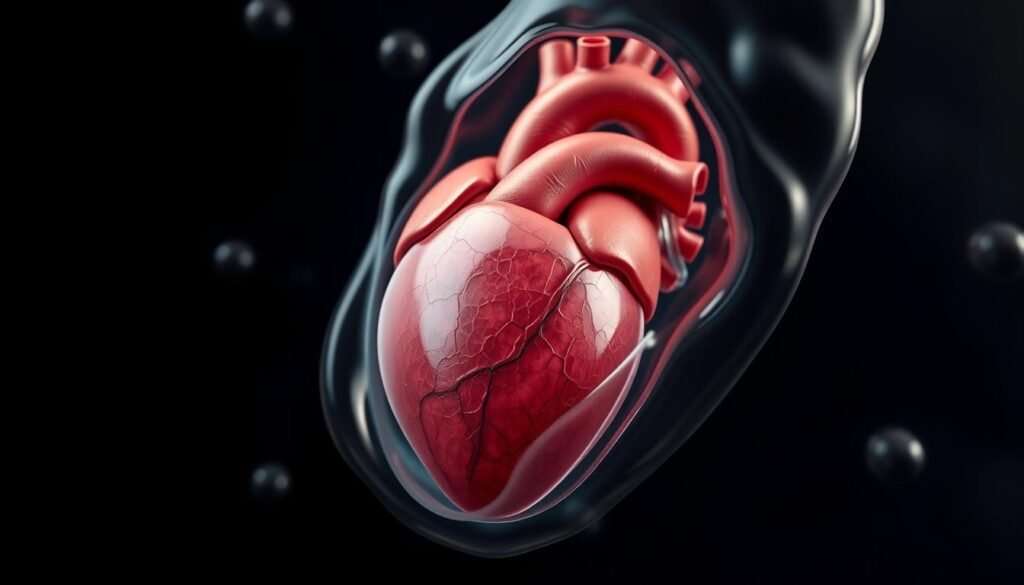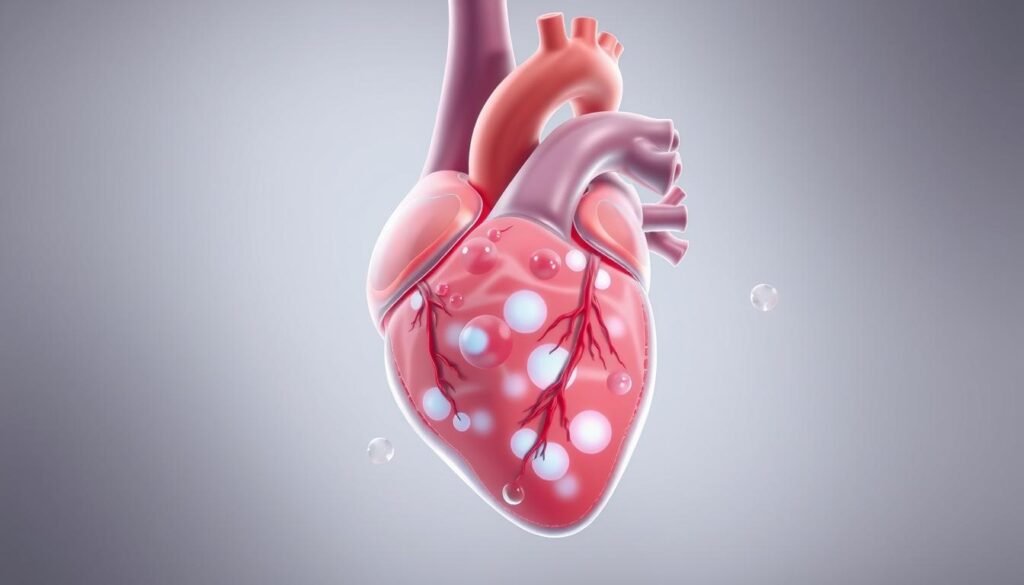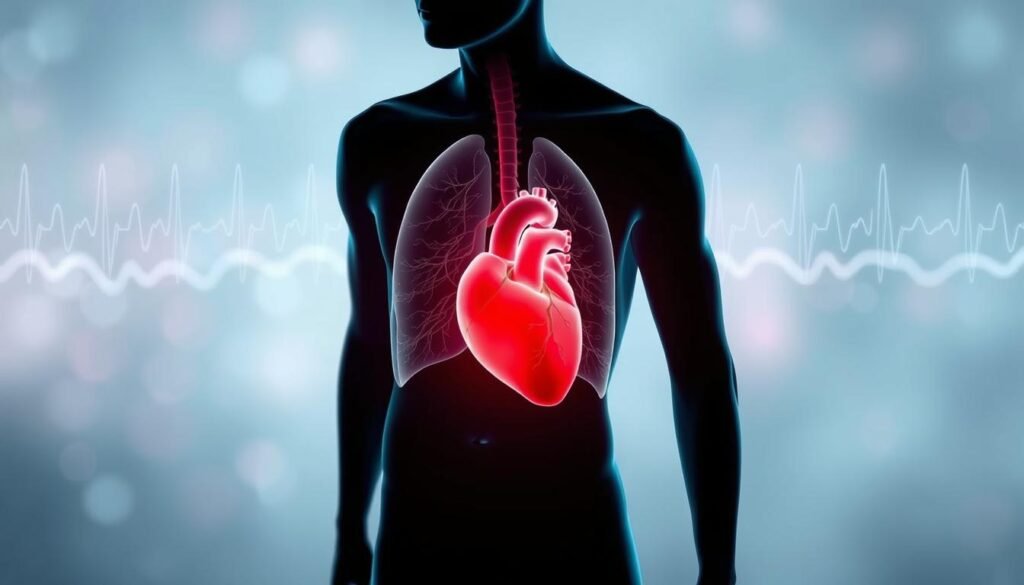Did you know that nearly 85% of lung cancer cases are Non-Small-Cell Lung Cancer (NSCLC)? This fact shows how common the disease is. It also points out the risk of fluid building up around the heart, known as pericardial effusion. Knowing about lung cancer fluid around the heart life expectancy is vital. It affects prognosis and the choice of treatment.
Lung cancer can lead to serious issues like malignant pleural effusion and pericardial effusion. These complications can lower survival rates. Shockingly, patients with malignant pericardial effusion usually have a survival time of only 2.1 months after surgery. This fact underlines the importance of being informed about health and treatment choices.
It’s key to understand what lung cancer fluid around the heart means for treatment and care. This article will explore lung cancer and its complications. We aim to provide insights into what patients go through and their outcomes.
Key Takeaways
- 85% of lung cancer cases are Non-Small-Cell Lung Cancer (NSCLC).
- Malignant pleural effusion and pericardial effusion are serious complications linked to lung cancer.
- The survival rate for patients with malignant pericardial effusion is only 2.1 months post-surgery.
- About 20.5% of people diagnosed with lung cancer survive at least five years.
- Understanding lung cancer fluid around heart life expectancy is crucial for managing treatment strategies.
Understanding Lung Cancer and its Complications
Lung cancer is the top cause of cancer deaths globally. It leads to serious health issues that harm patients’ life quality. The most common type is non-small cell lung cancer (NSCLC). Meanwhile, small cell lung cancer (SCLC) is quicker to spread and usually found in longtime smokers. Knowing about cancer staging is key in figuring out treatment and future outlook.
People with lung cancer face tough symptoms like breathing trouble, ongoing cough, and fluid in the chest. Pleural effusion is a major complication, often showing the cancer has progressed. It happens when cancer reaches the pleura, leading to more fluid build-up and worsening symptoms.
Late stages of lung cancer bring many complications due to its spread. Patients’ health generally gets worse as the cancer reaches more organs, making treatment harder. For instance, pericardial effusion suggests serious issues, shown by abnormal thickening of the pericardial wall and lymph nodes. Spotting these issues early is crucial for better care.
Handling advanced lung cancer needs a well-thought-out approach. Treatment options can include chemotherapy, radiation, or specific drugs, based on the cancer type. Taking care of complications is just as important, often needing a team of experts. For more details on these issues and how to manage them, check out this article on lung cancer-related complications.
What is Fluid Around the Heart?
Pericardial effusion is when fluid builds up around the heart. This fluid is in a space called the pericardial cavity. If this condition isn’t watched closely, it can cause big problems. Too much fluid can stop the heart from working right. This leads to cardiac tamponade, a serious issue. It happens when the fluid’s pressure stops the heart from filling up with blood properly.
Many things can cause pericardial effusion, including cancer. In fact, lung cancer is a common cause. Studies show that 72% of people with cancer-related pericardial effusion had lung cancer. This shows how serious fluid buildup can be if it’s linked to cancer. Quick action is key.
It’s important to know if pericardial effusion is benign or malignant. Benign cases might not need immediate treatment. This is especially true if they’re small, not changing, and not causing symptoms. But if the fluid buildup is big and linked to cancer, quick treatment is vital. This helps avoid cardiac tamponade, which has severe symptoms and risks.
Treating this fluid buildup is critical. Options include simple procedures like needle aspiration or more complex surgeries. Dealing with the underlying issue, such as cancer, can help control the pericardial effusion.

Causes of Fluid Accumulation Around the Heart
It’s key to know why fluid gathers around the heart. Diseases like lung cancer can lead to pericardial effusion. Cancer cells might attack the pericardium, making fluid build up. This can harm how the heart works a lot.
Cancer ranks third as a cause of pleural effusion, after heart failure and pneumonia. It’s common in lung, mesothelioma, breast, and ovarian cancers. These can also cause a lot of pericardial effusion cases.
But not all causes are due to cancer. Infections, some drugs, and kidney failure can create similar problems. Finding the exact reason helps doctors pick the best treatment.
Tests like echocardiograms and CT scans are crucial for spotting pericardial effusion. Normally, the sac around the heart has a little fluid. But with effusion, this can jump up a lot. About 21% of people with cancer get pericardial effusion. Quick medical help can stop things like heart failure or worse.

Treating pericardial effusion might involve drugs, draining the fluid, or surgery. What works best can differ for each person. This is why doctors need to examine carefully to decide on the best approach.
| Cause | Type | Common Treatments |
|---|---|---|
| Lung Cancer | Malignant | Medications, pericardiocentesis, surgery |
| Mesothelioma | Malignant | Surgery, chemotherapy, radiation |
| Heart Failure | Non-Malignant | Diuretics, lifestyle changes |
| Kidney Failure | Non-Malignant | Dialysis, medications |
| Infections | Non-Malignant | Antibiotics, supportive care |
Symptoms of Pericardial Effusion
Knowing the pericardial effusion symptoms is key for early treatment. This condition causes fluid to build up around the heart. It leads to several signs we need to know.
Chest pain is often felt by those with pericardial effusion. The pain might be sharp or more of a dull ache. Many also have shortness of breath, which can interfere with daily life. Difficulty breathing is very common in these cases.
Other symptoms include:
- Chest fullness
- Lightheadedness
- Swelling in the abdomen or legs
The seriousness of the symptoms can vary. It depends on how much fluid has built up and how fast. In severe situations, this can lead to cardiac tamponade. That’s when the fluid pressure stops the heart from pumping well.

It’s critical to notice these pericardial effusion symptoms early. This is especially true for those with diseases like lung cancer. Early detection can really help shape the treatment plan and improve chances of recovery.
The Link Between Lung Cancer and Fluid Around the Heart
Lung cancer can deeply affect health, causing complications like pericardial effusion. This condition means fluid builds up around the heart. It’s often found in patients with metastatic disease. About 72% of people with malignant pericardial effusion have lung cancer. This shows a strong connection that affects treatment plans.
When lung cancer spreads, it can reach the pericardium. This leads to pericardial effusion and can affect the heart. Doctors use a procedure called pericardiocentesis to remove this fluid. It helps ease symptoms and improves life quality.
Having pericardial effusion is common in lung cancer patients. This fact emphasizes the need for ongoing care and specific treatments. Studies suggest surgery can boost survival rates, especially if there’s no pericardial metastasis. Those without cancer in the fluid often fare better. This underscores the role of thorough imaging and tests in treatment choices.
| Factor | Impact on Survival |
|---|---|
| No pericardial metastasis | Improved outcomes |
| Cytopathologic confirmation of malignant PE | Reduced overall survival |
| Age (median of 57 years) | Varied impact based on overall health |
| Presence of other malignancies (e.g., breast cancer) | Mixed influence on survival rates |
Healthcare providers must know about the link between lung cancer and pericardial effusion. It helps them make better choices for their patients’ care. By understanding this relationship, they can apply treatments early. This approach aims at enhancing patient outcomes and managing symptoms well.
Lung Cancer Fluid Around Heart Life Expectancy
Fluid around the heart due to lung cancer is a big challenge. Survival rates help us know what to expect. Studies show that this condition, known as malignant pericardial effusion, greatly affects life expectancy. This is common in late-stage lung cancer. Sadly, 30% of patients die within a month of diagnosis. Only 9% live longer than two years.
Survival Rates for Lung Cancer Patients with Pericardial Effusion
The survival rates for those with lung cancer and heart fluid differ widely. It depends on many factors. For instance, nearly 65% of those with localized lung cancer can live for five years. Yet, the outlook for stage 4 lung cancer is around 5%. With metastatic non-small cell lung cancer, survival drops to 8%. These rates are crucial for making treatment choices and setting expectations.
Factors Impacting Life Expectancy
Several prognostic factors affect life expectancy in lung cancer patients with heart fluid. Key influencers include:
- Age: Younger patients usually have better survival rates.
- General Health: Existing health issues can worsen the prognosis.
- Cancer Stage: Early stages of cancer offer a better chance of survival than later stages.
- Response to Treatment: Positive reactions to treatment can extend life.
The average age at lung cancer diagnosis is 70, highlighting the increased risk in the elderly. Nevertheless, treatment advancements could improve survival prospects. It’s vital to talk to doctors about personal prognosis. Catching cancer early is key, as it can lead to better outcomes. For tips on early detection, click here.
Treatment Options for Fluid Around the Heart
Handling fluid around the heart requires a plan based on the patient’s needs. There are many treatments available. They include surgeries, non-surgical methods, and care aimed at easing symptoms.
Surgical Procedures: Pericardial Window and More
When fluid buildup threatens health, surgery might be needed. A pericardial window creates an opening to let fluid drain. This is done under general anesthesia to help with future drainage. Before choosing this, patients should talk about possible risks like infection and bleeding with their doctor.
Non-Surgical Methods: Pericardiocentesis and Sclerosis
If surgery isn’t an option, other methods can help. Pericardiocentesis uses a needle to take out the fluid, offering quick symptom relief. Then, chemicals may be used to prevent the problem from coming back. These options have quicker recovery times, which many find appealing.
Palliative Care Approaches
Palliative care is vital for managing symptoms from fluid around the heart, especially with certain cancers like lung cancer. It helps with both physical comfort and emotional support. Offering comprehensive care, palliative teams improve life quality and assist in treatment decisions.
| Treatment Type | Description | Pros | Cons |
|---|---|---|---|
| Surgical: Pericardial Window | Creation of an opening in the pericardium for drainage. | Long-term relief from fluid buildup. | Risk of infection, longer recovery time. |
| Non-surgical: Pericardiocentesis | Needle insertion to drain fluid. | Immediate symptom relief, minimal recovery. | Temporary solution, potential for recurrence. |
| Palliative Care | Holistic support for managing chronic symptoms. | Improves quality of life and emotional support. | May not directly resolve fluid accumulation. |
Impact on Quality of Life
Lung cancer affects patients’ lives deeply, especially with heart-related fluid issues. It’s crucial to manage symptoms well. This helps patients do daily activities with more ease. Palliative care aims to lessen symptoms like pericardial effusion, found in about 3% of lung cancer patients.
Managing Symptoms and Improving Comfort
End-of-life care focuses a lot on managing symptoms. Patients with malignant pericardial effusion face many challenges. These symptoms hinder daily life.
- Medication helps control pain and discomfort.
- Procedures like pericardiocentesis reduce heart pressure.
- Physical therapy is used to improve mobility.
Addressing these issues allows better patient experiences. It leads to improved life quality, despite advanced diseases.
Psychological Support and Care
Emotional support is crucial for patients and families during tough times. Clear communication about the illness helps create a supportive atmosphere. Care methods include:
- Counseling services for emotional support.
- Support groups for shared experiences.
- Spiritual advisors for holistic care.
These actions lessen anxiety and fear, making life more bearable. It’s key to support patients’ and families’ emotional wellbeing in dealing with lung cancer. Holistic assistance tackles both physical and emotional needs in tough times. For more information, click here.
Understanding Cancer Staging
Cancer staging is key in understanding how far the disease has spread, especially in lung cancer. It ranges from early cancer (TX, N0, M0) to more advanced stages (e.g., IIIB with T4, N2, M0). Knowing these stages helps doctors create effective treatment plans.
Lung cancer’s survival rates change a lot with its stages. For example, non-small cell lung cancer (NSCLC) shows a 65% survival rate at early stages. But this drops to only 9% at later stages. Early detection is crucial for a better survival chance. For more details, check this resource.
Staging guides doctors as they plan for any complications, like pericardial effusion. It shows how the stage affects survival and care plans. Knowing about these stages helps patients make better choices for their treatments.